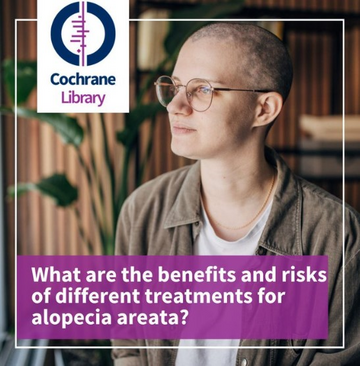Miriam Mateos-Haro,..., Sergio Vaño-Galván, Javier Zamora. Treatments for alopecia areata: a network meta-analysis.
Cochrane Database Syst Rev. 2023
"To obtain a synthesis of the available evidence of the treatments for alopecia areata, we have used systematic methodology, which generates objective, reliable and rigorous results. As a conclusion, only baricitinib resulted in a beneficial impact on hair regrowth with high certainty of evidence" - Dr. Javier Zamora & Miriam Mateos-Haro -
Summary:
Selection criteria: We included randomised controlled trials (RCTs) that evaluated classical immunosuppressants, biologics, small molecule inhibitors, contact immunotherapy, hair growth stimulants, and other therapies in paediatric and adult populations with AA.
Data collection and analysis: We used the standard procedures expected by Cochrane including assessment of risks of bias using RoB2 and the certainty of the evidence using GRADE. The primary outcomes were short-term hair regrowth ≥ 75% (between 12 and 26 weeks of follow-up), and incidence of serious adverse events. The secondary outcomes were long-term hair regrowth ≥ 75% (greater than 26 weeks of follow-up) and health-related quality of life. We could not perform a network meta-analysis as very few trials compared the same treatments. We presented direct comparisons and made a narrative
Main results: We included 63 studies that tested 47 different treatments in 4817 randomised participants. All trials used a parallel-group design except one that used a cross-over design. The mean sample size was 78 participants. All trials recruited outpatients from dermatology clinics. Participants were between 2 and 74 years old. The trials included patients with AA (n = 25), AT (n = 1), AU (n = 1), mixed cases (n = 31), and unclear types of alopecia (n = 4). Thirty-three out of 63 studies (52.3%) reported the proportion of participants achieving short-term hair regrowth ≥ 75% (between 12 and 26 weeks). Forty-seven studies (74.6%) reported serious adverse events and only one study (1.5%) reported health-related quality of life. Five studies (7.9%) reported the proportion of participants with long-term hair regrowth ≥ 75% (greater than 26 weeks). Amongst the variety of interventions found, we prioritised some groups of interventions for their relevance to clinical practice: systemic therapies (classical immunosuppressants, biologics, and small molecule inhibitors), and local therapies (intralesional corticosteroids, topical small molecule inhibitors, contact immunotherapy, hair growth stimulants and cryotherapy). Considering only the prioritised interventions, 14 studies from 12 comparisons reported short-term hair regrowth ≥ 75% and 22 studies from 10 comparisons reported serious adverse events (18 reported zero events and 4 reported at least one). One study (1 comparison) reported quality of life, and two studies (1 comparison) reported long-term hair regrowth ≥ 75%. For the main outcome of short-term hair regrowth ≥ 75%, the evidence is very uncertain about the effect of oral prednisolone or cyclosporine versus placebo (RR 4.68, 95% CI 0.57 to 38.27; 79 participants; 2 studies; very low-certainty evidence), intralesional betamethasone or triamcinolone versus placebo (RR 13.84, 95% CI 0.87 to 219.76; 231 participants; 1 study; very low-certainty evidence), oral ruxolitinib versus oral tofacitinib (RR 1.08, 95% CI 0.77 to 1.52; 80 participants; 1 study; very low-certainty evidence), diphencyprone or squaric acid dibutil ester versus placebo (RR 1.16, 95% CI 0.79 to 1.71; 99 participants; 1 study; very-low-certainty evidence), diphencyprone or squaric acid dibutyl ester versus topical minoxidil (RR 1.16, 95% CI 0.79 to 1.71; 99 participants; 1 study; very low-certainty evidence), diphencyprone plus topical minoxidil versus diphencyprone (RR 0.67, 95% CI 0.13 to 3.44; 30 participants; 1 study; very low-certainty evidence), topical minoxidil 1% and 2% versus placebo (RR 2.31, 95% CI 1.34 to 3.96; 202 participants; 2 studies; very low-certainty evidence) and cryotherapy versus fractional CO2 laser (RR 0.31, 95% CI 0.11 to 0.86; 80 participants; 1 study; very low-certainty evidence). The evidence suggests oral betamethasone may increase short-term hair regrowth ≥ 75% compared to prednisolone or azathioprine (RR 1.67, 95% CI 0.96 to 2.88; 80 participants; 2 studies; low-certainty evidence). There may be little to no difference between subcutaneous dupilumab and placebo in short-term hair regrowth ≥ 75% (RR 3.59, 95% CI 0.19 to 66.22; 60 participants; 1 study; low-certainty evidence) as well as between topical ruxolitinib and placebo (RR 5.00, 95% CI 0.25 to 100.89; 78 participants; 1 study; low-certainty evidence). However, baricitinib results in an increase in short-term hair regrowth ≥ 75% when compared to placebo (RR 7.54, 95% CI 3.90 to 14.58; 1200 participants; 2 studies; high-certainty evidence). For the incidence of serious adverse events, the evidence is very uncertain about the effect of topical ruxolitinib versus placebo (RR 0.33, 95% CI 0.01 to 7.94; 78 participants; 1 study; very low-certainty evidence). Baricitinib and apremilast may result in little to no difference in the incidence of serious adverse events versus placebo (RR 1.47, 95% CI 0.60 to 3.60; 1224 participants; 3 studies; low-certainty evidence). The same result is observed for subcutaneous dupilumab compared to placebo (RR 1.54, 95% CI 0.07 to 36.11; 60 participants; 1 study; low-certainty evidence). For health-related quality of life, the evidence is very uncertain about the effect of oral cyclosporine compared to placebo (MD 0.01, 95% CI -0.04 to 0.07; very low-certainty evidence). Baricitinib results in an increase in long-term hair regrowth ≥ 75% compared to placebo (RR 8.49, 95% CI 4.70 to 15.34; 1200 participants; 2 studies; high-certainty evidence). Regarding the risk of bias, the most relevant issues were the lack of details about randomisation and allocation concealment, the limited efforts to keep patients and assessors unaware of the assigned intervention, and losses to follow-up.
Authors' conclusions: We found that treatment with baricitinib results in an increase in short- and long-term hair regrowth compared to placebo. Although we found inconclusive results for the risk of serious adverse effects with baricitinib, the reported small incidence of serious adverse events in the baricitinib arm should be balanced with the expected benefits. We also found that the impact of other treatments on hair regrowth is very uncertain. Evidence for health-related quality of life is still scant.
Why do you highlight this publication?
There are multiple treatment options for alopecia areata, but it is unclear how helpful they are in producing hair regrowth.
To synthetize the available evidence in a reliable way, it is mandatory to use sistematic methodology, which allows the quality evaluation of the scientific publications and the summary of their results in an objective, explicit and rigurous manner.
Cochrane is an institution which generates summaries of the evidence using high-quality methodology, contributing to the healthcare knowledge and decision-making in the clinical practice.
In this work, only baricitinib resulted in a beneficial impact on hair regrowth with high certainty of evidence. More high-quality studies are needed to evaluate other potentially useful treatments.
Publication commented by:
Dr Javier Zamora & Miriam Mateos-Haro
Ramón y Cajal University Hospital



